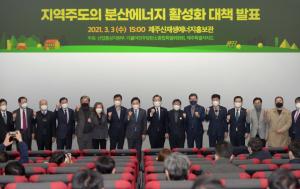Ministry of Industry announced’Regional-led measures to revitalize distributed energy Realization of regional-led energy system
Establishment of decentralized energy infrastructure and preparation of measures to minimize renewable energy output in Jeju
Promote’customized microgrid project’ to establish various energy systems reflecting regional characteristics
Establishment of’Regional Energy Center’… Allowed special cases for electric power transactions designated as’Distributed Energy Special Zone’
System stabilization ESS 23MWh First built in Jeju Island… Introduced the’Plus DR System’ in Jeju Island
Securing reverse transmission performance for #1·2 HVDC between Jeju and land… Two-way transmission #3 HVDC Completed at the end of 2022

[에너지데일리 변국영 기자] A distributed energy system led by the region will be established.
The Ministry of Trade, Industry and Energy was jointly hosted by the Ministry of Industry, the Democratic Party’s Carbon Neutrality Special Committee, and the Jeju Provincial Office at the New and Renewable Energy Promotion Center in Jeju Island on the 3rd. Energy revitalization measures’ announced.
‘Regional-led measures to revitalize distributed energy’ contains measures that can be implemented in the short term among the contents of the’Roadmap for Activation of Distributed Energy’ in consideration of the situation in Jeju, where a distributed energy system is essential due to the high proportion of renewable energy.
The Ministry of Industry and Industry have devised measures to minimize the output of renewable energy in Jeju as a major measure to achieve the goal of’building a regional-led distributed energy system’ ▲ realizing a regional-led energy system ▲ building a decentralized energy infrastructure ▲
Realization of regional-led energy system
A customized microgrid project will be promoted to supply and connect various distributed power sources in the village and to establish a variety of energy systems reflecting regional characteristics. For example, Woncheon Village in Hongseong-gun, Chungcheongnam-do produces energy by converting livestock manure into biogas and consumes it nearby. It is planning to discover and support such cases in Jeju Island as well.
In order to reinforce the energy implementation capacity of the region, the regional energy center will be established, and the regional energy plan will be advanced in cooperation with the Ministry of Industry, local governments, and specialized organizations.
In addition, regions that require systematic management of distributed resources due to the high proportion of distributed energy will be designated as special distributed energy zones to allow for special cases of electricity transactions such as demonstration of the integrated power plant and distribution network operator system, and direct transactions between producers and consumers.
Building a distributed energy infrastructure
In order to mitigate the volatility of renewable energy, a system stabilization ESS of 23MWh, which can accommodate additional 150MW of renewable energy, will be built first in Jeju Island in 2021. In Jeju Island, P2G technology that converts surplus power to hydrogen, P2H technology that converts to heat, and V2G technology that uses electric vehicles as ESS as a new flexible resource that will solve the renewable energy surplus power is planned to be demonstrated in Jeju Island.
In addition, Jeju Island will introduce a Plus DR system that provides incentives for consumption of surplus power from this month to solve the surplus power problem through a market mechanism. In addition, information providing devices for renewable energy generators (100kW or more) from Jeju Island. Is installed, and based on this, an integrated renewable energy control system is built that automatically predicts and controls renewable energy.
Minimization of renewable energy output control in Jeju
As renewable energy increases in Jeju Island, the power supply exceeding the power demand is inevitably increasing, and measures to minimize this are also being pursued. Jeju-Land #1 and #2 HVDC only sent electricity from land to Jeju Island, but it is expected to transmit surplus power in Jeju Island to land by securing reverse transmission performance, and Jeju Island’s renewable energy capacity is expected to increase to a maximum of 342MW in 2021. Furthermore, if the #3 HVDC, which enables real-time two-way transmission according to the power supply and demand situation between Jeju and land, is completed at the end of 2022, the renewable energy capacity of Jeju Island is expected to increase by 400MW.
The Ministry of Industry is planning to establish and announce a’roadmap for activating decentralized energy’ in the first half of the year, including mid- to long-term plans to improve the market system and incentive system. In the future, it plans to review and implement the’Special Act on Distributed Energy Activation,’ which is the legal basis to systematically support the transition to a distributed energy system.

Copyright © Energy Daily Unauthorized reproduction and redistribution prohibited
